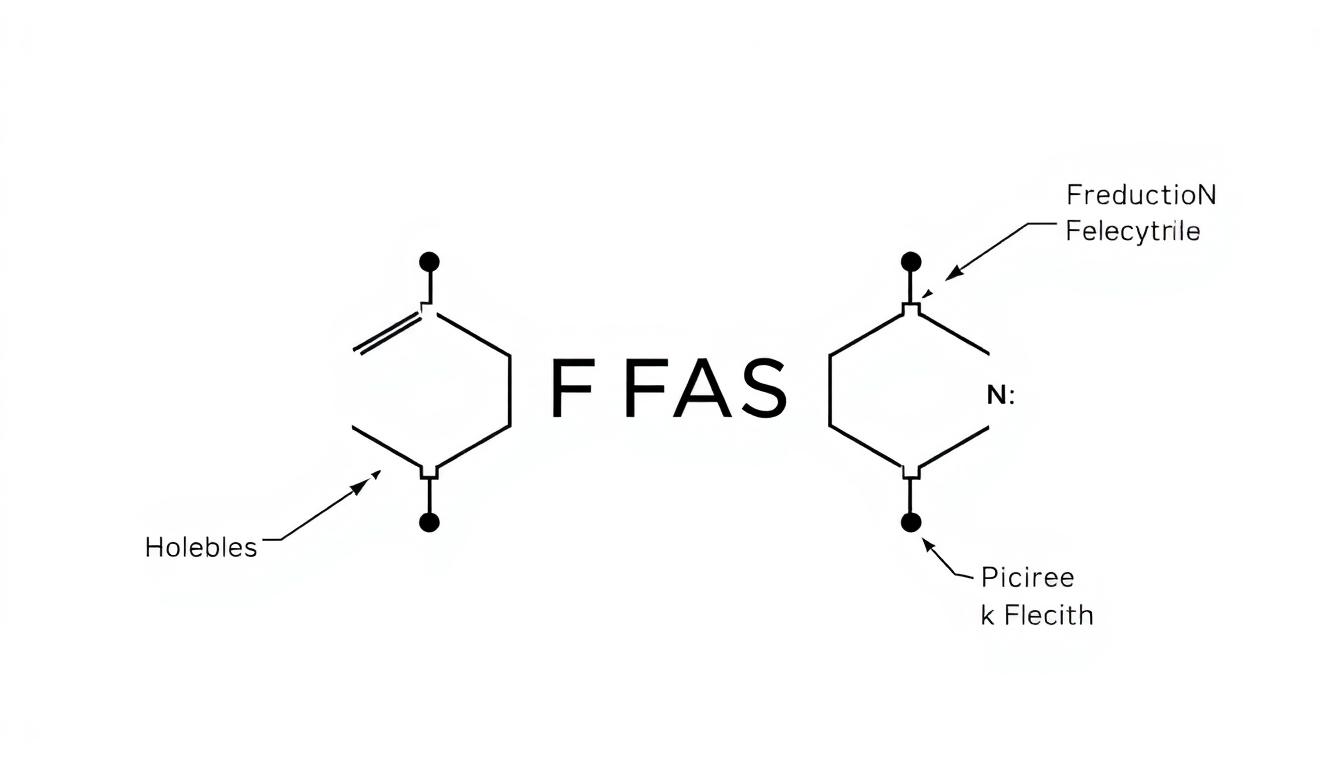
This investigation explores how these harmful chemicals infiltrate our food chain, the potential health consequences of long-term exposure, and most importantly, what you can do to protect yourself and your family while pushing for stronger industry oversight.
The carbon-fluorine bond in PFAS is one of the strongest in organic chemistry, making these chemicals extremely persistent in the environment.
What Are Forever Chemicals and Why Should You Be Concerned?
PFAS (per- and polyfluoroalkyl substances) earned the nickname “forever chemicals” because of their remarkable persistence. Created when carbon and fluorine atoms form an almost unbreakable bond, these synthetic compounds can remain intact in the environment and human body for decades—possibly centuries.
First developed in the 1930s, thousands of PFAS variants now exist, with new formulations continuously being created. They’ve become ubiquitous in modern life, appearing in everything from non-stick cookware and water-resistant clothing to food packaging and, as recent testing shows, the food itself.
Key Health Concerns Associated with PFAS Exposure:
- Suppressed immune system function
- Increased risk of certain cancers
- Liver damage
- Elevated cholesterol levels
- Decreased fertility
- Developmental delays in children
- Interference with hormones
- Lower birth weights
Dr. Graham Peaslee, Professor of Physics, Chemistry, and Biochemistry at the University of Notre Dame, explains: “What makes PFAS particularly concerning is their dual nature of persistence and mobility. They don’t break down naturally, and they can travel through water, soil, and air, eventually making their way into our food supply and our bodies.”
Recent Findings: PFAS Contamination in Grain Products
A 2024 study published in the Journal of Environmental Science and Technology detected PFAS in 72% of bread and cereal products tested, with concerning levels found in both conventional and organic varieties. The research team analyzed over 100 commonly consumed grain products from major retailers across the United States.
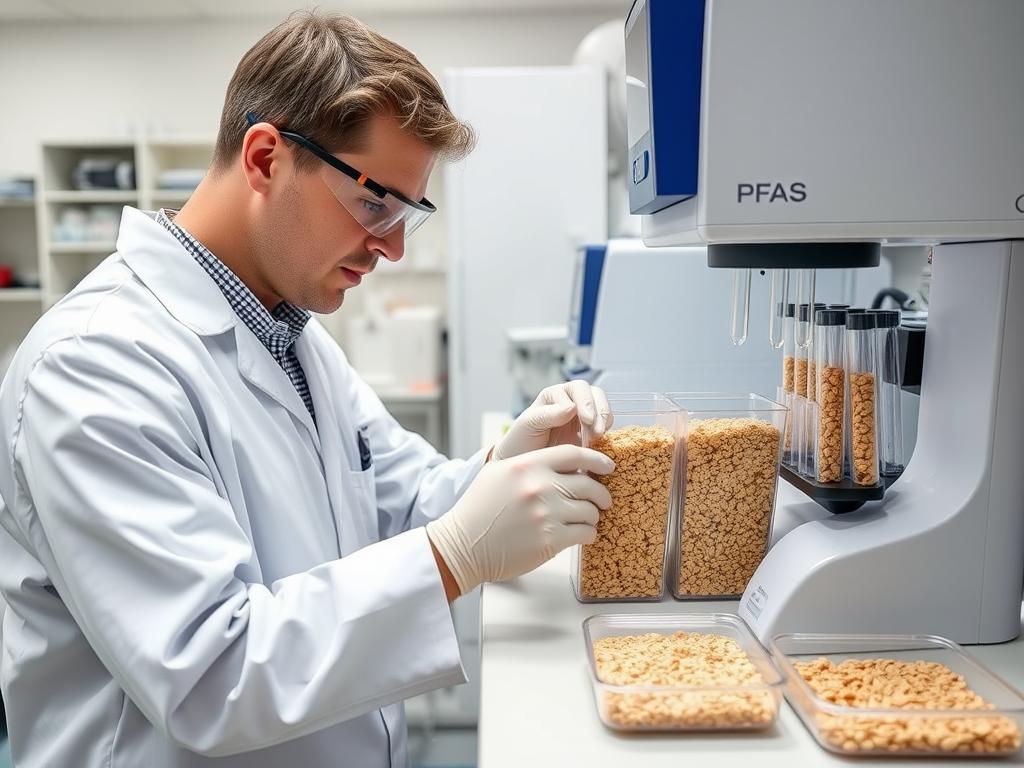
Testing for PFAS requires specialized equipment that can detect these chemicals at parts per trillion levels.
| Product Category | Samples Tested | % with Detectable PFAS | Average PFAS Level (ppt) |
| Sandwich Bread | 24 | 83% | 18.7 |
| Breakfast Cereals | 32 | 78% | 22.4 |
| Granola | 18 | 67% | 15.2 |
| Organic Bread | 14 | 71% | 12.8 |
| Organic Cereals | 16 | 69% | 14.3 |
Most Contaminated Products
- Conventional multi-grain sandwich bread (highest levels)
- Children’s sweetened breakfast cereals
- Granola with added dried fruits
- Whole wheat flour
- Organic oat-based cereals
- Conventional and organic tortillas
“What’s particularly troubling is that we found PFAS in products marketed specifically to children,” notes Dr. Linda Birnbaum, former director of the National Institute of Environmental Health Sciences. “Children are especially vulnerable to these chemicals because their bodies are still developing, and pound for pound, they consume more food and water than adults.”
How PFAS Infiltrate ‘Healthy’ Foods
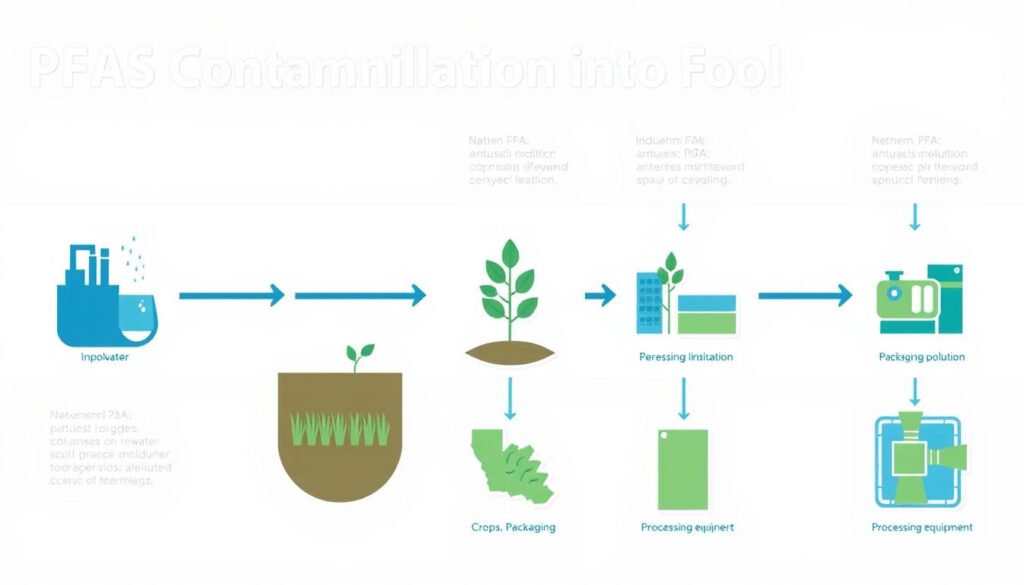
PFAS can enter our food through multiple pathways, creating a complex contamination challenge.
Understanding how these persistent chemicals find their way into our food supply is crucial. PFAS contamination follows multiple pathways:
Environmental Contamination
Industrial facilities that manufacture or use PFAS release these chemicals into the air and water. This pollution can travel for miles, contaminating farmland where grains are grown. Plants then absorb PFAS through their roots and incorporate them into the edible portions, including the grains used in breads and cereals.
Water Contamination
PFAS have been detected in both surface water and groundwater across the country. When this contaminated water is used for irrigation or food processing, it introduces these chemicals directly into the food production chain.
Food Processing Equipment
Many food processing facilities use equipment with PFAS-containing parts, such as conveyor belts, gaskets, and non-stick coatings. These materials can leach PFAS into food during manufacturing.
Packaging Materials
Even after production, foods can become contaminated through contact with packaging materials containing PFAS. These chemicals are commonly used in food packaging to repel grease and water, particularly in paper and cardboard containers.
Dr. Philippe Grandjean, an environmental medicine expert, explains: “What we’re seeing is a cycle of contamination. PFAS released into the environment decades ago are now returning to us through our food. And new PFAS continue to be introduced into the environment, ensuring this cycle will continue unless we take decisive action.”
The Organic Label Paradox
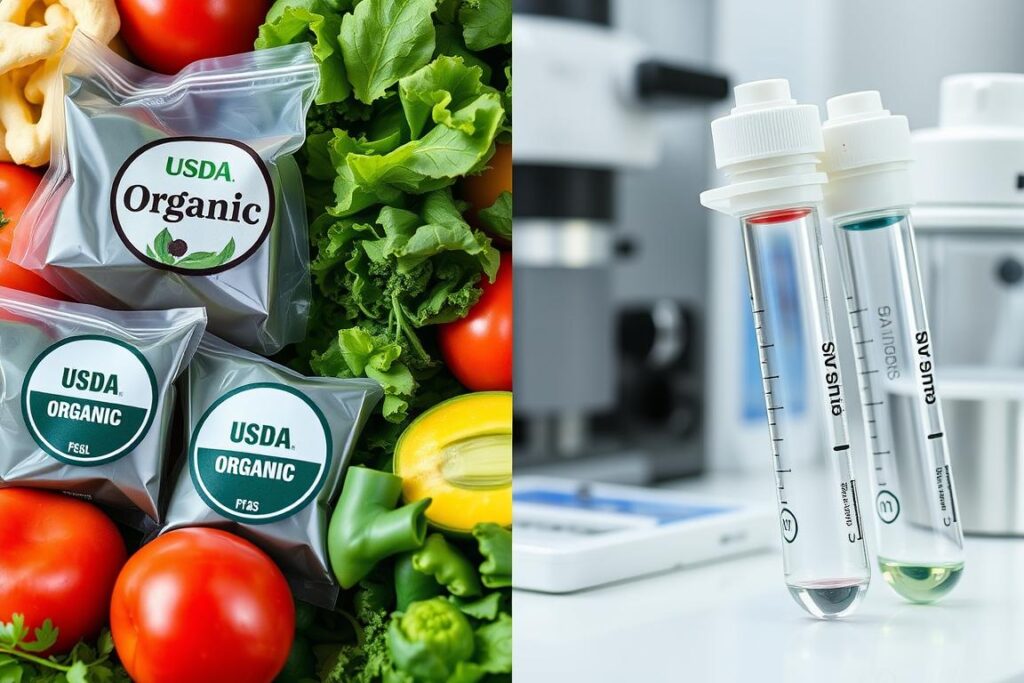
The USDA Organic label doesn’t guarantee products are free from PFAS contamination.
Many consumers turn to organic products assuming they’re free from harmful chemicals. However, the presence of PFAS in organic breads and cereals reveals a critical gap in organic certification standards.
The USDA Organic certification primarily focuses on farming practices—prohibiting synthetic pesticides, fertilizers, and GMOs. However, it doesn’t specifically test for or limit PFAS contamination. This creates a significant blind spot in food safety regulation.
“Organic standards were never designed to address legacy pollutants like PFAS that are now ubiquitous in our environment,” explains Charlotte Vallaeys, senior policy analyst at Consumer Reports. “Even the most conscientious organic farmer can’t prevent PFAS contamination if their water source or soil is already contaminated.”
Comparing Contamination Levels
While the study found PFAS in both conventional and organic products, there were some notable differences:
Conventional Products
- Higher average PFAS concentrations
- More likely to contain multiple PFAS compounds
- Greater variability in contamination levels
Organic Products
- Lower average PFAS concentrations (about 30% less)
- Fewer PFAS compounds detected per sample
- More consistent contamination levels across samples
This suggests that while organic farming practices may reduce some exposure pathways, they cannot eliminate PFAS contamination entirely. The lower levels in organic products likely reflect reduced exposure to contaminated sewage sludge (biosolids) used as fertilizer in conventional farming, which can contain high PFAS concentrations.
Health Impacts of Long-Term PFAS Exposure
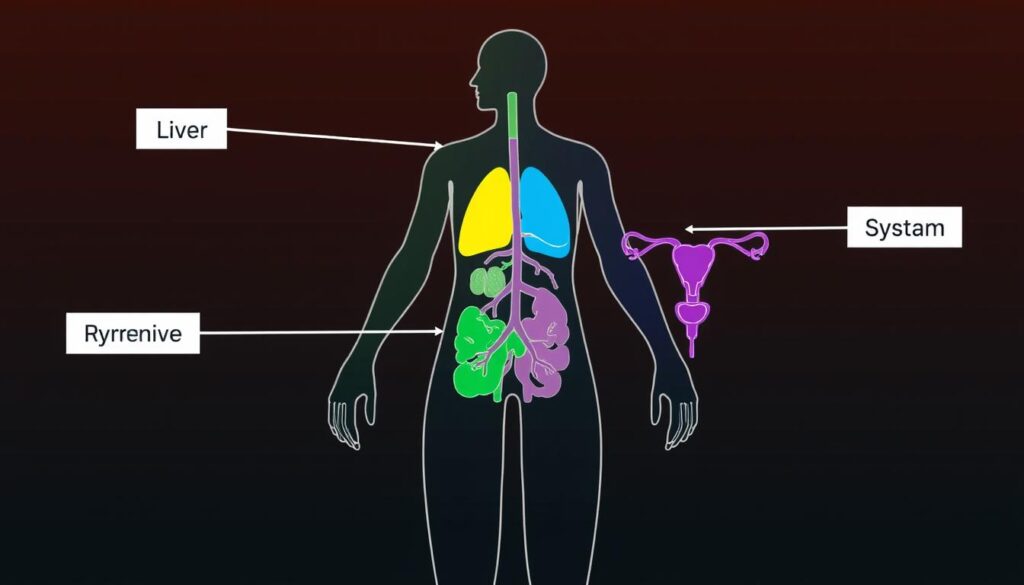
PFAS can affect multiple body systems, with some of the strongest evidence pointing to liver, immune, and hormonal effects.
The health risks associated with PFAS exposure are becoming increasingly clear as research advances. These chemicals can remain in the human body for years, accumulating over time and potentially causing a range of health problems.
What We Know About PFAS Health Effects
- Increased cholesterol levels
- Changes in liver enzymes
- Decreased vaccine response in children
- Increased risk of kidney and testicular cancer
- Decreased birth weight
- Thyroid hormone disruption
Emerging Concerns Under Investigation
- Potential links to autoimmune disorders
- Possible effects on brain development
- Suspected interference with metabolism
- Potential contribution to obesity
- Possible effects on fertility
- Links to more severe COVID-19 outcomes
Dr. Birnbaum emphasizes that the greatest concern is chronic, low-level exposure: “We’re not talking about acute poisoning. These are subtle effects that develop over years or decades of exposure. The real worry is that virtually everyone is exposed, starting before birth, and the chemicals never fully leave our bodies.”
Children face particular risks. Their developing bodies are more vulnerable to hormone-disrupting chemicals, and they have more years ahead for long-term effects to manifest. Recent research has linked early-life PFAS exposure to reduced immune response to vaccines, altered development, and potential cognitive effects.
Practical Steps to Reduce Your Exposure

Thoroughly washing grains before cooking can help reduce surface contamination from PFAS.
While completely avoiding PFAS exposure is nearly impossible in today’s world, you can take several practical steps to reduce your family’s exposure through food:
For Bread and Baked Goods:
- Choose bakeries that use simple, whole ingredients and minimal packaging
- Consider baking your own bread using organic flour and simple ingredients
- Avoid breads with artificial preservatives and numerous additives
- Transfer store-bought bread from plastic packaging to paper or cloth bags
For Cereals and Grains:
- Purchase whole grains in bulk when possible
- Rinse dry grains thoroughly before cooking
- Choose cereals with minimal ingredients and processing
- Make homemade granola using simple, whole ingredients

Glass, stainless steel, and silicone containers are safer alternatives to plastic for food storage.
Broader Strategies to Reduce PFAS Exposure
- Filter your drinking water with activated carbon or reverse osmosis filters certified to remove PFAS
- Avoid food packaging with grease-resistant coatings, especially for hot or fatty foods
- Transfer takeout food to home containers immediately
- Choose cookware without non-stick coatings (opt for cast iron, stainless steel, or ceramic)
- Check the EWG’s Food Scores database to find products with fewer concerning ingredients
- Support companies that have committed to phasing out PFAS in their products and packaging
Understanding Food Labels
No food label currently guarantees a product is PFAS-free. Terms like “natural,” “clean,” and even “organic” don’t address PFAS contamination. Look instead for companies that specifically mention testing for or working to eliminate PFAS in their products and supply chains.
Testing Methods and Limitations
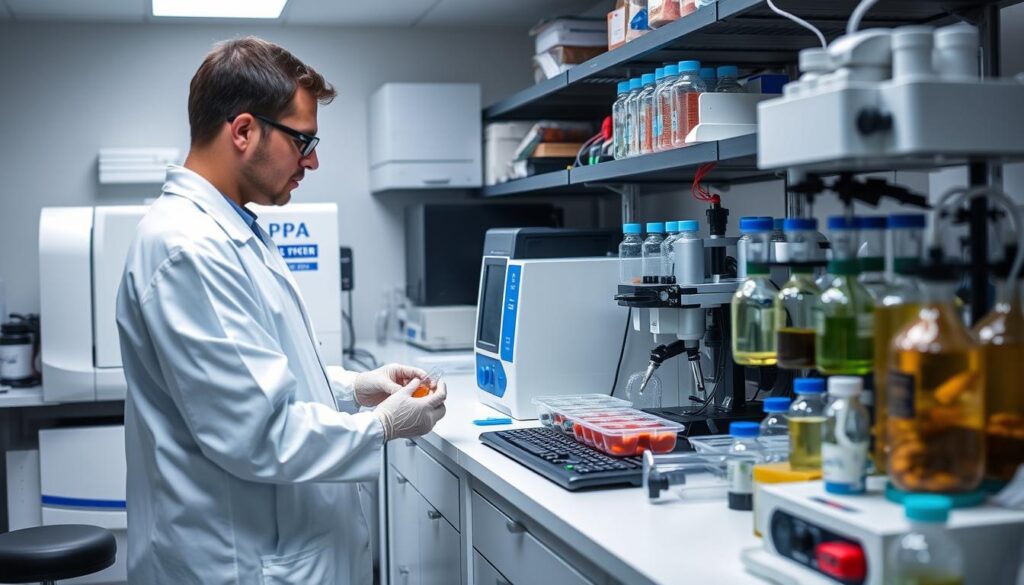
Testing for PFAS requires sophisticated equipment like high-performance liquid chromatography and mass spectrometry.
Understanding how PFAS are detected in food helps explain both the recent findings and the challenges in addressing this contamination.
Current Testing Approaches
Scientists typically use one of two approaches to test for PFAS in food:
Targeted Analysis
This method looks for specific, known PFAS compounds—typically a few dozen out of the thousands that exist. While precise, this approach can miss many PFAS that aren’t specifically included in the test.
Total Organic Fluorine (TOF)
This broader screening method measures the total amount of organic fluorine, which indicates the likely presence of PFAS. While it can’t identify specific compounds, it provides a more comprehensive picture of total PFAS content.
Dr. Peaslee explains the limitations: “When we test for specific PFAS compounds, we typically find they account for less than 1% of the total organic fluorine in a sample. This suggests the vast majority of PFAS present aren’t being captured by standard testing methods.”
This testing gap creates significant challenges for regulation and consumer awareness. If we can’t identify all the PFAS present in food, it’s difficult to assess the full extent of contamination or the specific health risks.
Want to Learn More About PFAS Testing?
Understand how scientists detect these chemicals and what current testing methods can and can’t tell us about food contamination.
Regulatory Gaps and Industry Response
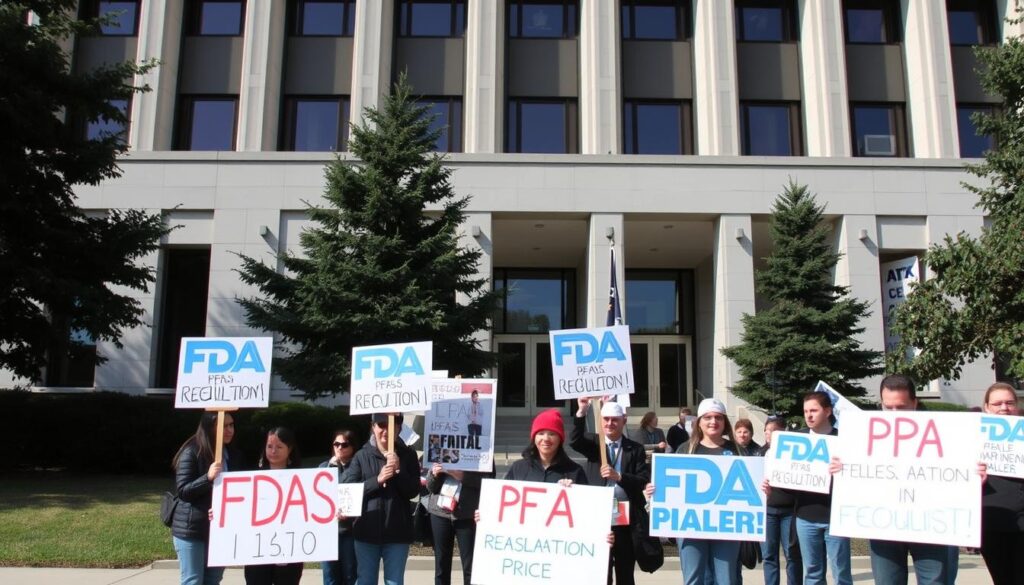
Advocacy groups have been pushing for stronger FDA regulation of PFAS in food products.
The current regulatory framework for PFAS in food has significant gaps. The FDA has established action levels for only a few PFAS compounds in drinking water, but comprehensive food standards are lacking.
Current Regulatory Status
- No federal limits exist specifically for PFAS in bread, cereals, or most other foods
- The FDA still allows some PFAS in food packaging and processing equipment
- Testing for PFAS in the food supply is limited and not systematic
- The USDA Organic program doesn’t address PFAS contamination
Some states are taking action where federal regulations fall short. California, for example, has banned intentionally added PFAS in food packaging, requiring levels below 100 parts per million of organic fluorine starting in 2023.
Industry Response
Food manufacturers have responded differently to growing PFAS concerns:
Proactive Companies
- Some have begun voluntary testing programs
- A few have committed to phasing out PFAS in packaging
- Some are working with suppliers to identify contamination sources
Resistant Companies
- Many claim PFAS are unavoidable environmental contaminants
- Some argue that trace levels pose no health risk
- Most oppose mandatory testing or strict limits
“The food industry’s response has been mixed at best,” says Dr. Michael Hansen, senior scientist at Consumer Reports. “While some companies are taking this seriously, many are waiting for regulations to force their hand rather than proactively addressing the issue.”
Taking Action: Beyond Individual Choices

Informed consumer choices can help drive market demand for safer products.
While individual actions to reduce exposure are important, addressing PFAS contamination in our food supply requires broader systemic change. Here’s how you can help push for stronger protections:
- Contact your representatives to support legislation restricting PFAS in food and packaging
- Sign petitions urging the FDA to establish strict limits for PFAS in food
- Support organizations working on food safety and chemical regulation reform
- Use your purchasing power to support companies committed to eliminating PFAS
- Share information about PFAS with friends and family to raise awareness
Dr. Birnbaum emphasizes the need for a precautionary approach: “We shouldn’t wait for absolute proof of harm before taking action to reduce these chemicals in our food supply. The evidence we already have warrants a much more aggressive approach to protecting public health.”
The presence of forever chemicals in our most basic foods—even those marketed as healthy or organic—highlights the need for comprehensive reform of our chemical regulatory system. Until then, informed consumer choices remain our best defense against this invisible threat.






